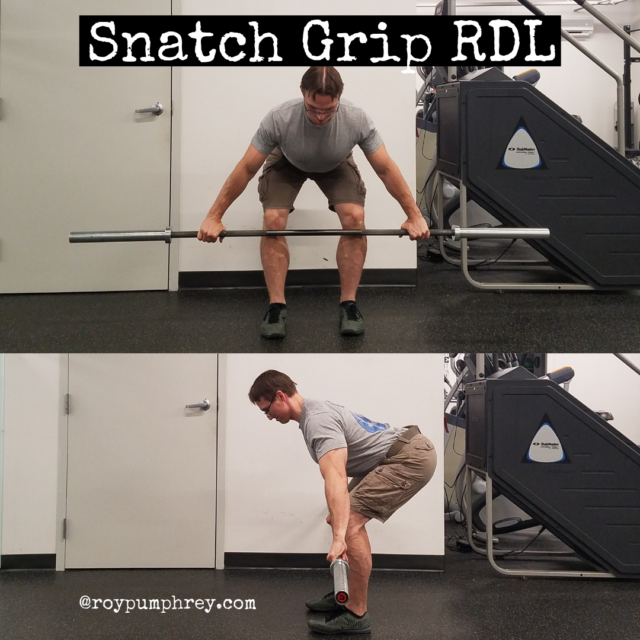
Deadlifts are Cool Again.
Wasn’t too long ago they weren’t.
But they are now, and in 3-5 years, they wont be again.
How Do I Know This?
I watch people do them on the reg and just because you picked it up off the ground, doesn’t make it a good deadlift.
“It’s Not a Deadlift That Hurt Your Back.
It’s What YOU Did, and Called a Deadlift,
That Hurt Your Back”
Here’s the common deadlift issues I see. <—-yes, they usually all go together.
- Arches collapsed
- Knees Collapsed
- Hips posteriorly tilted
- Low back rounded
- Thoracic spine rounded
- Shoulders out of the joint
- Reaching for the weight
- Knees driving forward (and in)
Why Do We DO This?
Poor motor patterning as a result of:
- Weak Assess
- Weak Hamstrings
- Searching out “cheap” mobility in the lumbar spine.
All resulting in the body finding and using the “path of least resistance”
BTW, this is 100% my opinion, but it is based on the evidence we have about backs, hips and motor patterns…..just saying.
Most People Have a Really Weak Ass and Hamstrings.
But a surprisingly strong low back.
Even if your low back hurts and you think its weak..
Your low back is probably stronger than you think…
“people with troubled backs use their backs more. Generally, they walk, sit, stand and lift using mechanics that increase back loads. Many of them have stronger backs but are less endurable than matched asymptomatic controls” – Designing Back Exercise: From Rehabilitation to Performance
Why Not Bend Through the Low Back Rather Than Hinge The Hips?
Almost sounds like bending through the low back would be the correct movement strategy, if we have a weak ass and a strong low back, right?
Until you look at the structure of the hips vs the low back.
If I had to pick something up I think I’d rather use the system that has:
- More muscles
- More muscle mass
- Larger bones
- Can produce greater torque (has greater muscle pennation)
Not the one that is several, much smaller joints, with limited flexion/ extension capabilities undergoing massive shear forces.
But that’s just me.
So Why Do I Use My Low Back?
Well, because your ass got weak and you stopped using it.
“They (low back pain patients) tend to have more motion in their backs and less motion and load in their hips. A common aberrant motor pattern is known as “gluteal amnesia” (McGill, 2007) which may be both a common consequence of back troubles and probably a cause of them as well. –Designing back Exercise From Rehabilitation to Performance
You used to use your hips at one time.
When you were a kid.
Maybe it was as far back as a toddler.
But I guarantee you used to have a beautiful hip hinge and use your glutes all the time.
All little kids do.
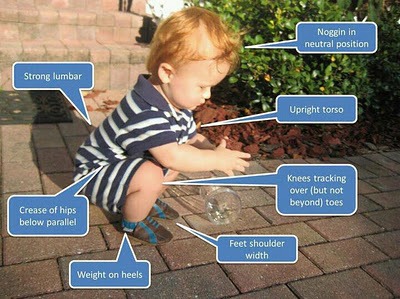 hell of a hip hinge, from the PTDC
hell of a hip hinge, from the PTDC
They have to.
Hip strength and endurance are prerequisites to go from crawling into standing and then walking.
Seriously, next time you see a 2 or three year old, look at there butts.
*But try not to be all creepy about it, perv.
But(t) seriously, they all have pretty well developed glutes, they need them to support the pelvis in standing then walking.
They hinge their hips and sit back to reach an object on the ground.
They use there glutes all the time.
How The Hell Did I Loose My Hip Hinge / Ass?
You did too many low force/ velocity/ amplitude movements.
Modern life is nothing but these types of movements.
Sprinting, jumping, climbing, carrying heavy things.
Those are the types of activities the glutes are made for.
“Overall, our data suggest that the large size of the GMAX (glute max) reflects its multifaceted role during rapid and powerful movements rather than as a specific adaptation for a single submaximal task such as endurance running.” –
Comparatively your quads and probably the TFL and IT band got activated a lot more, in all your activities of daily living (ADL’s), while your hips were essentially dormant.
Stairs, walking, picking things up with the well meaning but totally wrong, “Lift With Your Legs”, all are quad dominant activities.
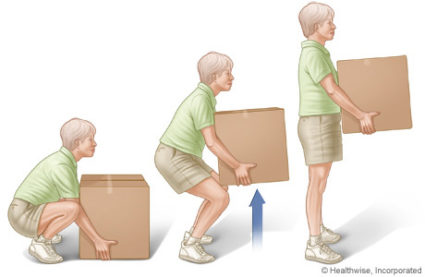 There’s a lot of BS going on here, especially in this picture:
There’s a lot of BS going on here, especially in this picture:
- Heels up: No hip involvement, you’re FORCED to drive ONLY through the ball of the foot and knee joint ie quadriceps.
- Pelvis tucked under: optimal Core bracing RELIES on a NEUTRAL Pelvis
- Weight is in front of the center of mass: Lever arm = larger than necessary
- The position of the pelvis from pic 1 to 2 changes: This is the primary mechanism of lumbar spine injury, movement of the segments under load.
Long story short: lifting, “with the legs” as shown in this picture will result in the knees taking on an unnecessarily high load and the back is still at risk for injury.
“Controversial recommendations such as “when lifting, bend the knees and keep the back straight” rarely address the real issue, despite their popularity. Few patients are able to use this strategy in their jobs and furthermore, this is often not the best strategy. For example, the “golfers lift” is much more joint conserving for repeated lifting of light loads from the floor. Another example illustrates the poor choice of movement strategies for a particular task.” – Designing back Exercise: From Rehabilitation to Performance
Lift With Your Legs Should Be, Lift With Your HIPS!
Lifting with your hips emphasizes hip hinging and lifting with the entire lower body complex.
“Lifting with your legs means utilizing your entire lower body to effectively pick up a weight or an object. Lifting with your legs means generating force through your hips and your knees together to absorb the weight. Lifting with your legs means allowing your back and your entire core to stabilize to support the agonist and antagonist muscles of your legs.
When lifting with your legs, the most effective technique to use is the hip hinge. This utilizes your posterior chain and your pulling mechanics to generate force. This results in stronger glutes, hamstrings, and lower back muscles.” – Lift With Your Back: Not Your Legs, Mastering The Hip Hinge
But(t) Loss of Your Ass Isn’t the Whole Story
You became a Desk Jockey.
You sit too damn much, slouched over, hanging off your ribcage.
So it locked stiffened up to help keep you “upright” and in place.
Stiff/ Immobile Thoracic Spine + Weak/ Immobile Hips =
Easy Motion is Found Through the Lumbar Spine.
Pretty simple:
- I can’t move through the top half of the spine.
- Don’t have the strength/ mobility/ “feel” to load the hips effectively and move through the bottom of the spine <—-in this I’m including the Sarcral/ Pelvis complex as the “spine” because for our purposes they work as a functional unit and as we’ve all learned by now, “glutes are core”.
If i’m too stiff at the top and bottom, I have to move through the middle. where there are NO HARD STRUCTURES to get in the way.
The lumbar spine.
We move through the lumbar spine because we’re lazy and it’s the easiest place we have to move because there are no bones (ribs or pelvis/ femoral head) to limit motion.
The Lumbar Spine Allows the Path of Least Resistance….
So we begin to move through the low back instead of the hips constantly loading, practicing, ingraining and strengthening this pattern.
While allowing the spine sparing, hip hinge pattern to weaken and erode.
We gotta get it back.
Learn to use the hips and spare the spine…
Snatch Grip RDL
The Snatch Grip RDL is almost magical.
I’m not entirely sure, but the Snatch Grip RDL tends to clean up a sloppy hip hinge about 75% of the time. <—-yes, sometimes this does mean using an empty barbell.
My best guess is because the shoulders are in front of the bar, if the only rule(s) are to keep the bar against you and slide it down your quads, you have to hip hinge to get it there.
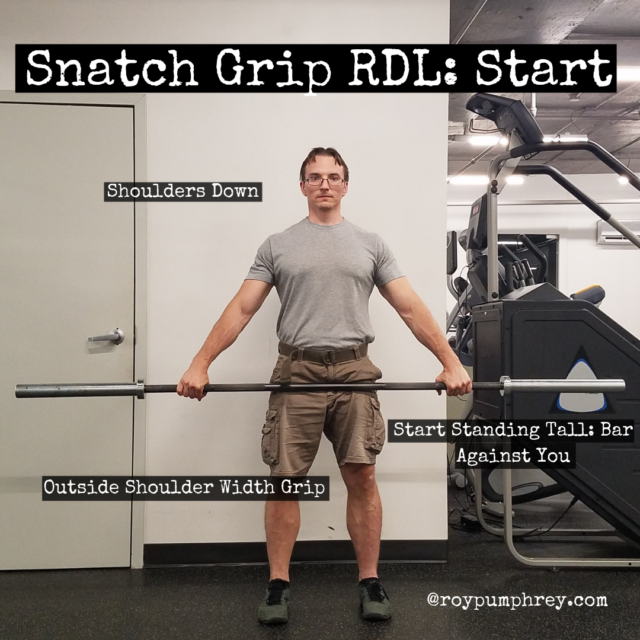
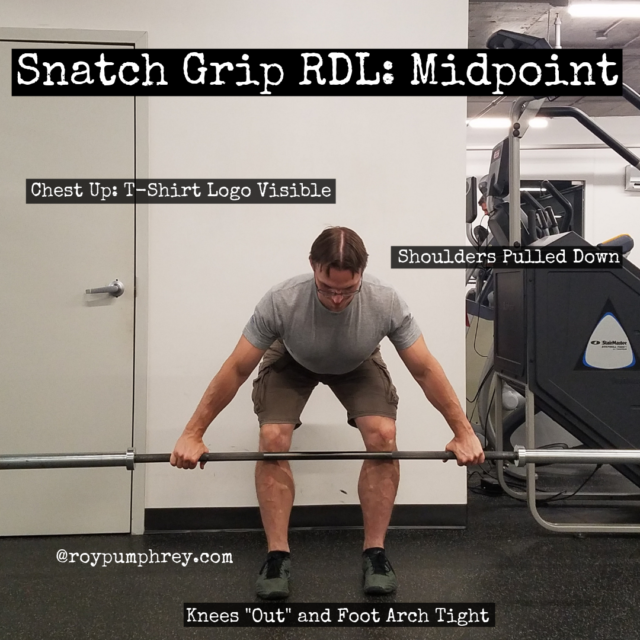
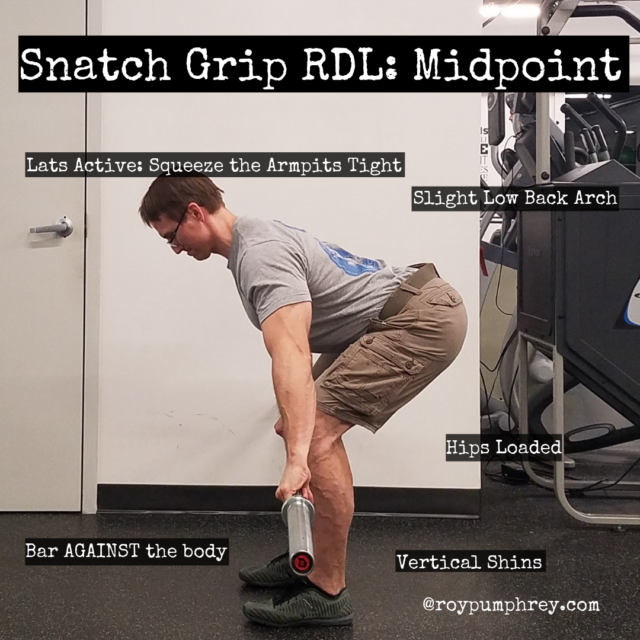 Checklist:
Checklist:
- Grip the bar wide. If the bar has snatch marks use those, if not, wider than shoulder width.
- Start standing tall: shoulders down, chest up, knees straight, hips under you.
- Try to “bend the bar” some to activate the upper back.
- Chest up: T-Shirt logo (not chin) up the whole time.
- Small arch in the lower back.
- Grip the floor
- Knees and arches never collapse
- VERTICAL shins (but soft knees)
- Push the hips back until you can’t push back no mo’
- PULL the hips through the top until standing tall.
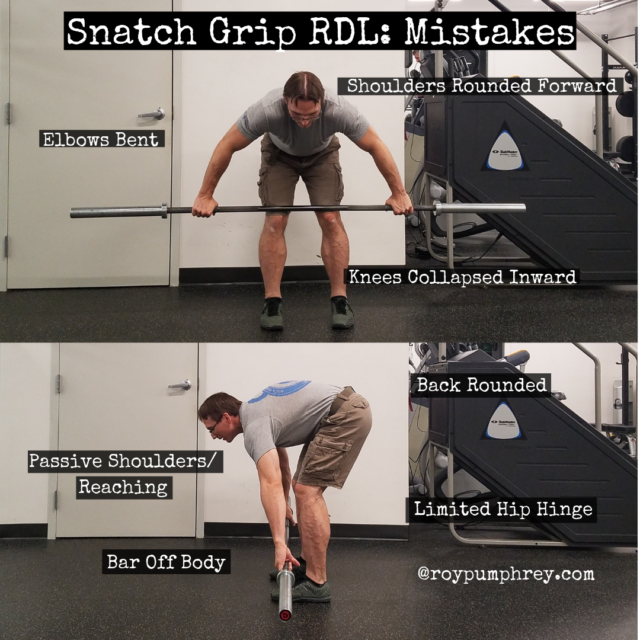 Bro Tips:
Bro Tips:
- Keep the bar against you you the whole time. DO NOT REACH OUT with the bar
- If you can’t grip it very well tuck the thumb under with a false grip. But still try to get some “bar bend” with the hands.
- When bending the bar, think shoulders down to push the armpits forward.
- Your range of motion is going to be shorter than a traditional RDL probably. Its cool. For most people its going to be around (just above or below) the kneecap.
- DON’T FORCE RANGE OF MOTION, let it come to you.
- If you have trouble maintaining vertical shins, stand in front of a bench with the calves very lightly touching the bench. If you push into the bench your shins moved back instead of staying vertical.
- Hard glutes at the top of the lift.
Never Done a Snatch Grip RDL Before?
DON’T Go HEAVY.
Stay light, start with a bar if need be.
Only add weight as you feel comfortable with the movement and feel like you’re controlling the hinge.
Ohh, just so you know, the Snatch Grip RDL has the potential to LIGHT UP your hamstrings and the whole of your back including the erector spinae muscles around the lumbar spine.
What I’m trying to tell you is, YES your low back will probably be sore.
But not in a, “through my spine. My disks are F-ed way”.
And more in a “good”, muscle soreness, way.

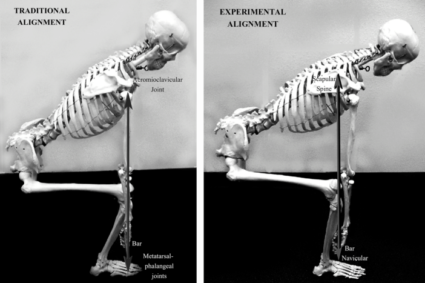


[…] Hips, Hips, Hips. […]